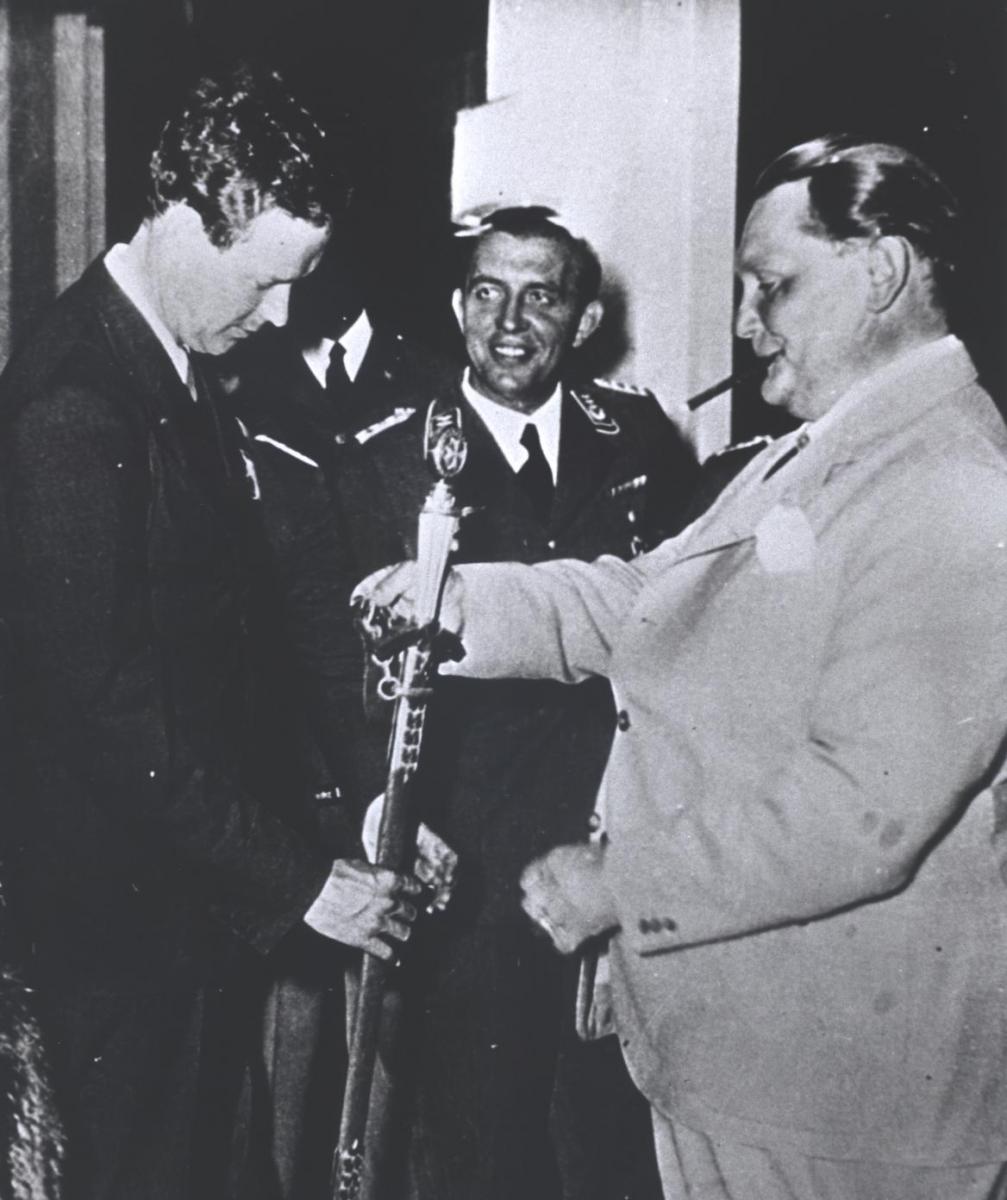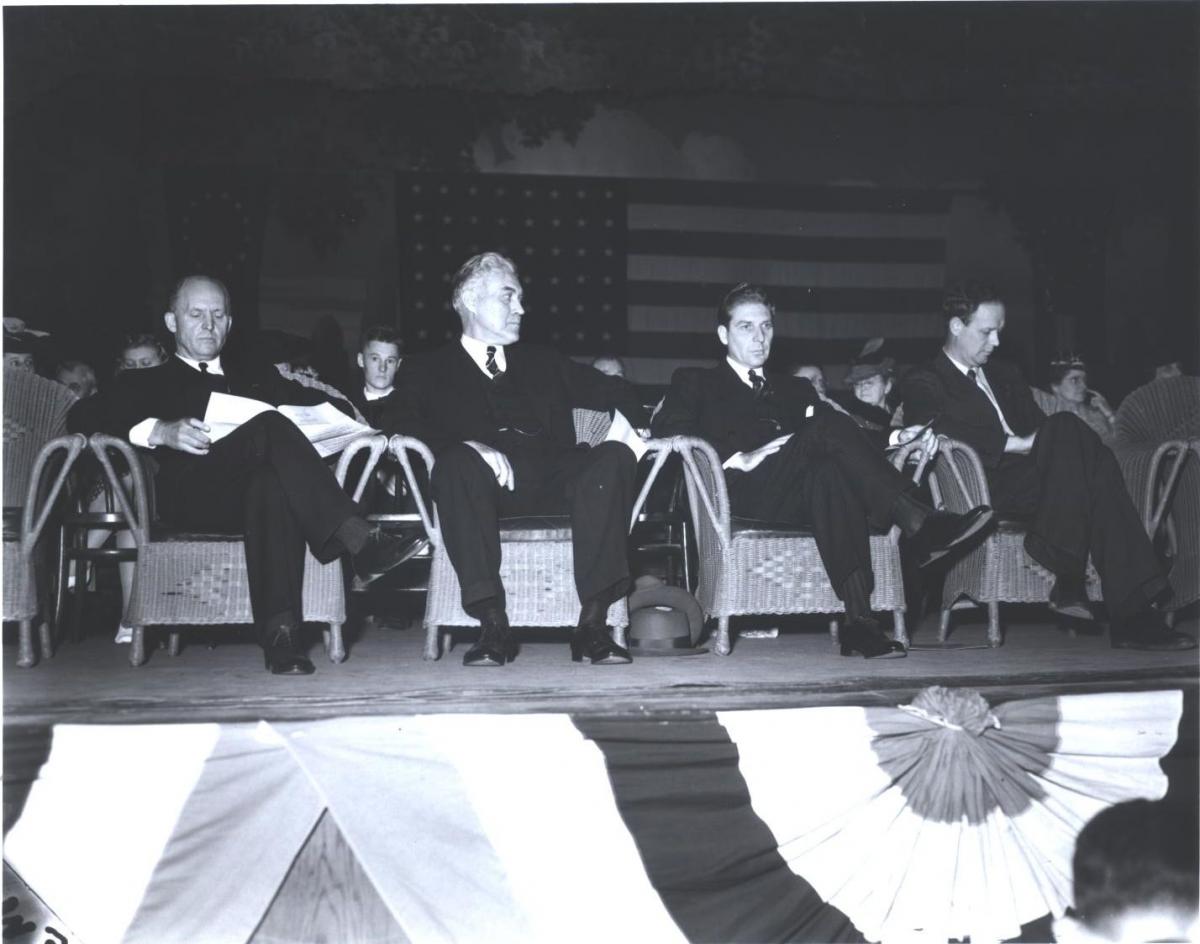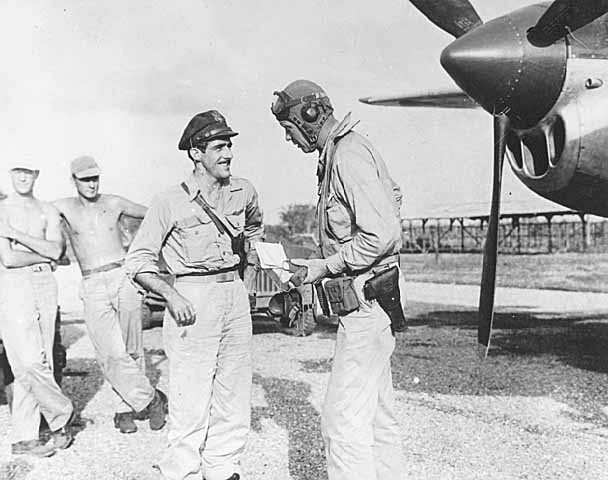Did Lindbergh Have Family in Germany During World War 2
America Outset and WWII
Echoing his father's isolationist political views, Charles Lindbergh spent the latter one-half of the 1930s fighting to go on the United States out of Europe'south second globe war.
Lindbergh became increasingly unsettled by the public attention surrounding him and his family unit in the wake of the kidnapping and Hauptmann trial. In December 1935, he and Anne moved the family to Europe, where they hoped to live more private lives.
For nearly 4 years they lived in England and France, making only i brief vacation visit to the United States in December 1937. During this time, the Lindberghs spent time studying and writing.
In 1936, at the request of officials at the American Embassy in Berlin, Lindbergh was invited to Germany to help gather intelligence about the Reich's growing military air power. With the admiring approving of German language Air Minister Hermann Goering, Lindbergh toured combat units, factories, airports, and armed services bases, including some that had never been seen past an American.
Afterwards his tours, Lindbergh ended that Frg was "now able to produce war machine shipping faster than any European country; possibly even faster than nosotros could in us. ... A person would have to be bullheaded not to realize that they have already built upward tremendous strength."
Lindbergh made several more visits to German factories and airfields over the next two years. On Oct 18, 1938, Lindbergh attended a dinner in Berlin with several distinguished guests. That evening Goering presented Lindbergh with the Service Cross of the German Hawkeye for his services to world aviation.
Although the medal had previously been presented to other strange dignitaries visiting Germany — such every bit Henry Ford and IBM chairman Thomas Watson — the award to Lindbergh came as a surprise to everyone at the event. Many saw Lindbergh's acceptance of the "Nazi medal" as a sign of Lindbergh's sympathies with the 3rd Reich, and he was vilified in the American press.
Lindbergh remained convinced that Germany would win any coming war based on its superior military strength. The Lindberghs decided that the safest place for the family was dorsum in us, and in April 1939, they returned to New York.

Charles Lindbergh with Hermann Goering.
America Kickoff and anti-Semitism
America Kickoff and anti-Semitism
Upon his return to the United States, Lindbergh began to actively work for the anti-interventionist cause. At the time, more than 80 percent of the American public shared his views, opposing any interest in the European disharmonize, which broke into open up warfare when Germany invaded Poland on Sep ane, 1939.
In his first radio address, Lindbergh warned against becoming "entangled in European alliances." His speech made headlines, drawing both support and criticism. Dorothy Thompson, a journalist and leading opponent of Hitler, attacked Lindbergh in her column, dismissing him as a "pro-Nazi recipient of a German language medal."
In 1940, Lindbergh spoke to the Yale University student chapter of the America First Committee, a nationwide arrangement that opposed American intervention in the war. Over the next twelvemonth he made thirteen more speeches for the group, officially joining in Apr 1941.
Lindbergh's position on American interests in the war effort assorted with that of President Franklin Roosevelt, and the ii men at times seemed to exist conducting a argue via radio addresses.
Every bit these debates continued, public criticism of Lindbergh's views and of the America First Committee grew. In his speech called "Who are the State of war Agitators?" delivered in Des Moines, Iowa, on Sep xi, 1941, Lindbergh argued that the Roosevelt administration, the British "race," and the "Jewish race" were pushing America towards war.
The printing and many members of the public were outraged that Lindbergh was injecting an unsavory tone of anti-Semitism in his argument for neutrality, a claim that he denied. The speech severely damaged the reputations of both Lindbergh and the America First movement, and in November, he resigned equally spokesman, saying he needed to devote more time to his writing efforts, specifically the book that became The Spirit of St. Louis in 1953.
The surprise set on on Pearl Harbor past the Japanese on Dec 7, 1941, compelled an end to Lindbergh's opposition to the war, and to the work of the American First Committee.

America First meeting at Minneapolis Auditorium
Lindbergh hoped to return to the armed services, but during his time with the America Commencement Committee, he had publicly resigned from the Army Air Corps. Secretarial assistant of War Henry L. Stimson questioned Lindbergh'south loyalty and denied him a control.
Henry Ford hired Lindbergh as a technical advisor at his Willow Run, Michigan, constitute that was converting from automobile manufacture to production of B-24 Liberator bombers. In 1943, Lindbergh joined United Aircraft, and also chaired the Aeromedical Unit for Inquiry in Aviation Medicine at the Mayo Clinic in Rochester, Minnesota, in club to help advance high-distance flying.
In 1944, Lindbergh persuaded United Aircraft to designate him a technical representative in the South Pacific to study aircraft performances under combat conditions. Traveling via Hawaii, Midway, Palmyra, Funafuti, Bougainville, and Green Island, Lindbergh arrived in New Guinea in late April, two months afterwards leaving the Us.
Despite being a noncombatant, Lindbergh flew on dawn patrols, joined rescue missions, and flew whatsoever gainsay mission that would go him to the front lines, and taught immature pilots how to conserve fuel and fly longer-range missions.
When Lindbergh left the S Pacific in September 1944, he had participated in 50 combat missions, and was credited with at least one impale — an event that profoundly afflicted him and which he wrote virtually in his book-length essay, Of Flight and Life (1948).

Charles Lindbergh with Tommy McGuire, S Pacific, Summer 1944
Resource
Berg, A. Scott. Lindbergh. New York: Berkley Books, 1998.
"Charles Lindbergh's Noninterventionist Efforts & America Commencement Committee Involvement." www.charleslindbergh.com
Cole, Wayne Southward. Charles A. Lindbergh and the Battle Against American Intervention in Globe War II. New York: Harcourt Brace Jovanovich, 1974.
Dinnerstein, Leonard. Antisemitism in America. New York: Oxford University Press, 1994.
Duffy, James P. Lindbergh vs. Roosevelt: The Rivalry that Divided America. New York: MJF Books, 2010.
Friedman, David M. The Immortalists: Charles LIndbergh, Dr. Alexis Carrel, and Their Daring Quest to Alive Forever. New York: HarperCollins Publishers, 2007.
Lindbergh, Charles A. The Wartime Journals of Charles A. Lindbergh. New York: Harcourt Caryatid Jovanovich, Inc., 1970.
Lindbergh, Anne Morrow. State of war Within and Without: Diaries and Messages of Anne Morrow Lindbergh 1939-1944. New York: Harcourt Brace Jovanovich, 1980.
Lindbergh, Anne Morrow. The Moving ridge of the Future: A Confession of Faith. New York: Harcourt, Brace and Company, 1940.
Newton, James. Uncommon Friends: Life with Thomas Edison, Henry Ford, Harvey Firestone, Alexis Carrel & Charles Lindbergh. San Diego: Harcourt, Inc., 1987.
Olson, Lynne. Those Angry Days: Roosevelt, Lindbergh, and America'southward Fight Over World War II, 1939-1941. New York: Random House, 2013.
Smith, Truman. Berlin Alarm: The Memoirs and Reports of Truman Smith. Edited past Robert Hessen. Stanford, CA: Hoover Establishment Printing, 1984.
Wallace, Max. The American Centrality: Henry Ford, Charles Lindbergh, and the Rising of the Tertiary Reich. New York: St. Martin'southward Griffin, 2003.
Willis, Matthew B. The Lindbergh Study: The Untold Story of Lindbergh'south Written report of September 22, 1938. Fundamental Milton Keynes, England: AuthorHouse United kingdom Ltd., 2008.
Source: https://www.mnhs.org/lindbergh/learn/controversies
0 Response to "Did Lindbergh Have Family in Germany During World War 2"
Post a Comment